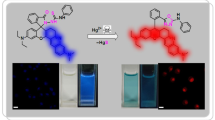Abstract
A novel fluorescent probe 9-(4-(1,2-diamine)benzene-N1-phenyl)acridine (DABPA) was synthesized for the detection of nitric oxide (NO) and characterized by IR, 1H-NMR and EI-MS spectroscopy. Based on a photoelectron transfer mechanism, the fluorescence intensities of DABPA were investigated with the different concentrations of NO. Under the optimal experimental conditions, the fluorescence intensity of DABPA had a good linear relationship (R 2=0.9977) with NO concentration in the range from 1×10−7 to 1.5×10−6 mol/L with a detection limit of 1×10−8 mol/L. The cytotoxicity induced by DABPA was evaluated by the MTT (3-(4,5-dimethylthiazol-2-yl)-2,5diphenyl tetrazolium bromide) assay for biological application. Furthermore, the probe DABPA had also been successfully applied to real-time image NO produced in PC12 cells in the presence of L-arginine.
Similar content being viewed by others
References
Furchgott RF, Zawadzki JV. The Obligatory Role of Endothelial Cells in the Relaxation of Arterial Smooth Muscle by Acetylcholine [J]. Nature, 1980, 288: 373–376
Palmer MJ, Ferrige AG, Moncada S. Nitric Oxide Release Accounts for the Biological Activity of Endothelium-derived relaxing Factor [J], Nature, 1987, 327: 524–526
Moncada S, Higgs A. The L-arginine-nitric Oxide Pathway[J]. N. Engl. J. Med., 1993, 329: 2 002–2 012
Ignarro LJ, Cirino G, Casini A, Napoli C. Nitric Oxide as a Signaling Molecule in the Vascular System: an Overview [J]. J. Cardiovasc. Pharmacol, 1999, 34: 879–886
Grisham MB, Johnson GG, Gatreaux MD, et al. Measurement of Nitrate and Nitrite in Extracellular Fluids: a Window to Systemic Nitric Oxide Metabolism, METHODS: a Companion to Methods in Enzymology [M]. New York: Academic Press Inc., 1995, 7: 84–90
Abu-Soud H M, Icimori K, Presha A, et al. Electron Ttransfer, Oxygen Binding, and Nitric Oxide Feedback Inhibition in Endothelial Nitricoxide Synthase[J]. J. Biol. Chem, 2000, 275: 17 349–17 357
Stamler JS, Singel DJ, Loscalzo J. Biochemistry of Nitric Oxide and Its Redox Activated Forms [J]. Science, 1992, 258: 1 898–1 902
Gross WL, Bak MI, Ingwall JS, et al. Nitric Oxide Inhibits Creatine Kinase and Regulates Rat Heart Contractile Reserve[J]. Proc. Natl. Acad. Sci. USA, 1996, 93: 5 604–5 609
Green LC, Wagner DA, Glogowski J, et al. Analysis of Nitrate, Nitrite, and [15N]_Nitrate in Biological Fluids [J]. Anal. Biochem., 1982, 126: 131–138
Lozinsky EM, Martina LV, Shames AI, et al. Detection of Nitric Oxide from Pig Trachea by a Fluorescence Method [J]. Analytical Biochemistry, 2004, 326: 139–145
Miserere S, Ledru S, Ruille N, et al. Biocompatible Carbon-based Screen-printed Electrodes for the Electrochemical Detection of Nitric Oxide [J]. Electrochemistry Communications, 2006, 8: 238–244
Guo Z, Chen J, Liu H, et al. Direct Electrochemistry of Hemoglobin and Myoglobin at Didodecyldimethylammonium Bromide-modified Powder Microelectrode and Application for Electrochemical Detection of Nitric Oxide [J]. Analytica Chimica Acta, 2008, 607: 30–36
Kikuchi K, Nagano T, Hayakawa H, et al. Detection of Nitric Oxide Production from a Perfused Organ by a Luminol-hydrogen Peroxide System [J]. Anal. Chem., 1993, 65: 1 794–1 799
Nagano T, Yoshimura T. Bioimaging of Nitric Oxide [J]. Chem. Rev., 2002, 102: 1 235–1 269
Hirotatsu K, Naoki N, Kazuya K, et al. Detection and Imaging of Nitric Oxide with Novel Fluorescent Indicators: Diaminofluoresceins [J]. Anal. Chem., 1998, 70: 2 446–2 453
Kojima H, Hirotani M, Nakaysubo N, et al. Bioimaging of Nitric Oxide with Fluorescence Indicators Based on the Rhodamine Chromophore [J]. Anal. Chem., 2001, 73: 1 967–1 973
Huang KJ, Wang H, Ma M, et al. Real-time Imaging of Nitric Oxide Production in Living Cells with 1,3,5,7-tetramethyl-2,6-dicarbethoxy-8-(3,4,-diaminophenyl)-difluoroboradiaza-s-indacence by Invert Fluorescence Microscope[J]. Nitric Oxide: Biology and Chemistry, 2007, 16: 36–43
Frank DP, Polyphosphoric Acid in the Bernthsen Reaction [J]. J. Organic Chemistry, 1962, 27: 2 658–2 659
Birchall JM, Thorpe DH. Rearrangements of Diphenylamine Derivatives. Part II. Rearrangement of Some N-Aroyldiphenylamines and the Intermolecular Character of the Reaction[J]. J. Chem. Soc. C, 1968, 23: 2 900–2 904
Plater MJ, Greig I, Helfrich MH, et al. The Synthesis and Evaluation of o-phenylenediamine Derivatives as Fluorescent Probes for Nitric Oxide detection[J]. J. Chem. Soc. Perkin. Trans., 2001, 1: 2 553–2 559
Hu JX, Yin LL, Xu KH, et al. Vicinal Diaminobenzoacridine Used as the Fluorescent Probe for Trace Nitric Oxide Determination by Flow Injection Spectrofluorimetry and Macrophage Cells Imaging [J]. Analytica Chimica Acta, 2008, 606: 57–62
Sasaki E, Kojima H, Nishimatsu H, et al. Highly Sensitive Near-Infrared Fluorescent Probes for Nitric Oxide and Their Application to Isolated Organs[J]. J. Am. Chem. Soc. 2005, 127: 3 684–3 685
Zhang X, Chi R, Zou J, et al. Development of A Novel Fluorescent Probe for Nitric Oxide Detection: 8-(3′,4′-diaminophenyl)-difluoroboradiaza-S-indacence[J]. Spectrochimica Acta Part A, 2004, 60: 3 129–3 134
Author information
Authors and Affiliations
Corresponding author
Additional information
These two authors contributed equally to the manuscript
Funded by the National Natural Science Foundation of China (Nos. 50802069, 81100890, 51272191), the Fundamental Research Funds for the Central Unversities (WUT: 2013-IV-010), and the Students Innovation and Entrepreneurship Training Program of WHUT(20141049701012)
Rights and permissions
About this article
Cite this article
Ding, L., Yuan, F., Huang, L. et al. A novel fluorescence probe 9-(4-(1,2-diamine)benzene-N1-phenyl)acridine for nitric oxide determination. J. Wuhan Univ. Technol.-Mat. Sci. Edit. 29, 848–853 (2014). https://doi.org/10.1007/s11595-014-1007-3
Received:
Accepted:
Published:
Issue Date:
DOI: https://doi.org/10.1007/s11595-014-1007-3




